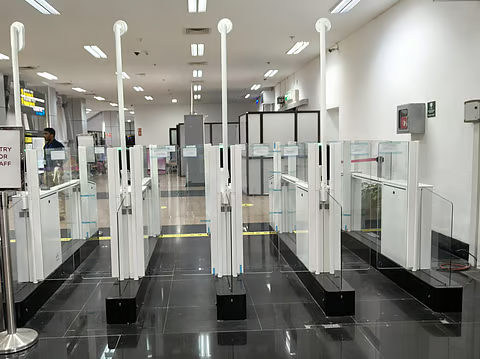International travel to and from India has become smoother with the introduction of e-Gates at major airports. These automated gates, installed under the DigiYatra initiative, promise quicker immigration clearance and shorter queues. However, for Non-Resident Indians (NRIs), the process to access these e-Gates involves specific documentation and eligibility steps. Interestingly, Aadhaar, India’s most widely used identity document, is not accepted as proof for NRIs.
This article explains how NRIs can register for e-Gate access, what documents are required, and the reason behind Aadhaar being excluded as a valid proof of identity for overseas Indians.
Understanding the e-Gate System in India
The e-Gate system, introduced by the Bureau of Immigration, aims to automate the immigration process at Indian airports. It allows eligible passengers to pass through electronic gates using biometric verification instead of waiting in long queues for manual stamping.

The system uses e-Passport technology, which contains a microchip embedded with biometric and demographic data. Once the e-Gate verifies the traveler’s details, it grants access automatically, saving time and reducing human contact.
For NRIs, this feature is particularly useful since they frequently travel to and from India and often face long immigration lines. But before they can enjoy the convenience of the e-Gate, NRIs must complete the registration process carefully.

Who Can Apply for e-Gate Access
e-Gate access in India is currently available to:
- Indian citizens holding a valid e-Passport
- Overseas Citizens of India (OCI) cardholders
- Non-Resident Indians (NRIs) with Indian passports
While Indian citizens can easily apply using Aadhaar or passport details, NRIs and OCIs need to rely solely on passport-based identification. This distinction plays an important role in understanding why Aadhaar is not accepted for them.
Step-by-Step Guide: How NRIs Can Apply for e-Gate at Indian Airports
1. Visit the Official Immigration Website
NRIs can begin their registration by visiting the Bureau of Immigration’s official website. This is where the e-Gate registration portal is available for new users.
2. Create a User Account
You’ll need to create an account using your email ID and contact number. Make sure to use a valid email since all confirmation messages and instructions are sent there.
3. Upload Required Documents
For NRIs, the following documents are required:
- A valid Indian passport with an embedded electronic chip (e-Passport)
- A recent passport-size photograph (as per ICAO standards)
- Proof of overseas residence (such as residence visa, Green Card, or foreign ID)
4. Provide Travel Details
You’ll be asked to enter your travel details such as recent arrival or departure information. This helps the immigration system verify your travel history.
5. Biometric Verification
Once your application is verified online, you will need to complete biometric enrollment at an Indian airport equipped with e-Gate facilities. Airports like Delhi, Mumbai, Bengaluru, and Hyderabad currently offer this service.
6. Activation and Access
After your biometrics are successfully recorded, your e-Gate access will be activated. You can then use the e-Gate lanes for faster immigration clearance during future travel.
Why Aadhaar Cannot Be Used as Proof by NRIs
One of the most common questions asked by NRIs is why Aadhaar cannot be used for e-Gate registration. The answer lies in the legal and eligibility framework surrounding Aadhaar itself.
Aadhaar is for Residents, Not NRIs
Aadhaar is issued only to individuals who have resided in India for at least 182 days in the 12 months preceding the date of application. Since most NRIs live abroad for extended periods, they do not qualify as “residents” under Aadhaar regulations.
Legal Restrictions
The Unique Identification Authority of India (UIDAI) specifically states that Aadhaar is meant for residents of India. Using Aadhaar as proof by NRIs who are not legally residents could lead to inconsistencies or even legal complications in identity verification systems.
Passport Serves as the Primary Proof
For NRIs, the passport remains the most valid and globally recognized form of identity. It carries biometric data and international recognition, making it the ideal document for e-Gate verification.
Therefore, the Indian government restricts the use of Aadhaar for NRIs to ensure that the e-Gate system maintains accurate, lawful, and consistent identity verification standards.
Documents NRIs Should Keep Ready
To make the e-Gate registration process smooth, NRIs should prepare the following documents in advance:
- Valid e-Passport (mandatory)
- Overseas address proof (residence card, visa, etc.)
- Email ID and contact number for communication
- Recent digital passport-size photograph
Having these documents ready ensures quick verification and avoids delays in registration approval.
Which Airports in India Offer e-Gate Facilities
Currently, e-Gate services for NRIs and other passengers are available at several major international airports in India. These include:
- Indira Gandhi International Airport, New Delhi
- Chhatrapati Shivaji Maharaj International Airport, Mumbai
- Kempegowda International Airport, Bengaluru
- Rajiv Gandhi International Airport, Hyderabad
- Chennai International Airport, Chennai
- Cochin International Airport, Kochi
The government plans to expand this facility to more airports as part of the larger DigiYatra and immigration modernization initiatives.
Benefits of Using e-Gate for NRIs
1. Faster Immigration Process
One of the biggest advantages of e-Gates is speed. The automated process significantly reduces waiting time at immigration counters, allowing NRIs to pass through in seconds.
2. Contactless and Secure
Since e-Gates use biometric and electronic verification, they reduce physical contact and paperwork, ensuring a safer and more hygienic process — a major advantage in the post-pandemic world.
3. Seamless Travel Experience
For NRIs who travel frequently, e-Gate access adds convenience and predictability. It eliminates the need for manual stamping and reduces human errors during verification.
4. Global Compatibility
The Indian e-Gate system aligns with global airport security and immigration practices, making it easier for India to integrate with international travel systems.

Common Issues Faced by NRIs During Registration
While the process is straightforward, NRIs sometimes encounter a few challenges during e-Gate registration:
- Non-e-Passport Issues: If your passport does not contain an embedded electronic chip, it won’t be compatible with the e-Gate system.
- Photo Rejection: Low-quality or incorrect-sized photographs may be rejected during online submission.
- Delayed Verification: Overseas documentation may take longer to verify, especially for first-time applicants.
- Limited Airport Coverage: Not all airports in India currently support e-Gates, so travelers should plan accordingly.
To avoid these issues, applicants should ensure their documents meet the required standards and double-check information before submission.
Tips for NRIs to Smoothly Use e-Gate Services
- Renew your passport to an e-Passport before applying.
- Register your email ID that you frequently use to receive updates.
- Keep a printed copy of your registration confirmation during your next trip.
- Arrive early for your first e-Gate use, as biometric verification might take additional time.
- Always carry secondary identification, such as your OCI card or overseas visa, for backup verification.
Future of e-Gate and Digital Immigration in India
India’s move towards digital immigration aligns with its vision of becoming a global hub for smart travel technology. With e-Gates already operational at key airports, the next phase includes integrating facial recognition, AI-based identity checks, and real-time passenger data monitoring.
For NRIs, these developments mean easier and faster re-entry into India, fewer queues, and enhanced travel comfort. Over time, the government may expand eligibility criteria, simplify the documentation process, and add more airports to the e-Gate network.
Conclusion
The e-Gate system marks a major step forward in India’s digital travel infrastructure, offering NRIs a faster, more convenient way to move through immigration. While Aadhaar cannot be used as proof because it is limited to residents, NRIs can easily register using their e-Passport and overseas identification documents.
As technology continues to evolve, India’s airports are becoming smarter, and for NRIs, the journey home is becoming smoother than ever. The e-Gate system is not just about saving time — it represents the future of effortless, secure, and paperless travel for Indians worldwide.
Do follow UAE Stories on Instagram
Read Next – UAE Businesses Eye Global Success Through Powerful London Partnerships















